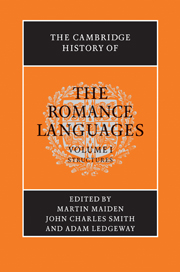Book contents
- Frontmatter
- Introduction
- 1 ROMANCE LINGUISTICS AND HISTORICAL LINGUISTICS: REFLECTIONS ON SYNCHRONY AND DIACHRONY
- 2 SYLLABLE, SEGMENT AND PROSODY
- 3 PHONOLOGICAL PROCESSES
- 4 MORPHOLOGICAL PERSISTENCE
- 5 MORPHOPHONOLOGICAL INNOVATION
- 6 CHANGE AND CONTINUITY IN FORM–FUNCTION RELATIONSHIPS
- 7 MORPHOSYNTACTIC PERSISTENCE
- 8 SYNTACTIC AND MORPHOSYNTACTIC TYPOLOGY AND CHANGE
- 9 PRAGMATIC AND DISCOURSE CHANGES
- 10 WORD FORMATION
- 11 LEXICAL STABILITY
- 12 LEXICAL CHANGE
- 13 LATIN AND THE STRUCTURE OF WRITTEN ROMANCE
- 14 SLANG AND JARGONS
- Notes
- References and bibliographical abbreviations
- Index
7 - MORPHOSYNTACTIC PERSISTENCE
Published online by Cambridge University Press: 28 May 2011
- Frontmatter
- Introduction
- 1 ROMANCE LINGUISTICS AND HISTORICAL LINGUISTICS: REFLECTIONS ON SYNCHRONY AND DIACHRONY
- 2 SYLLABLE, SEGMENT AND PROSODY
- 3 PHONOLOGICAL PROCESSES
- 4 MORPHOLOGICAL PERSISTENCE
- 5 MORPHOPHONOLOGICAL INNOVATION
- 6 CHANGE AND CONTINUITY IN FORM–FUNCTION RELATIONSHIPS
- 7 MORPHOSYNTACTIC PERSISTENCE
- 8 SYNTACTIC AND MORPHOSYNTACTIC TYPOLOGY AND CHANGE
- 9 PRAGMATIC AND DISCOURSE CHANGES
- 10 WORD FORMATION
- 11 LEXICAL STABILITY
- 12 LEXICAL CHANGE
- 13 LATIN AND THE STRUCTURE OF WRITTEN ROMANCE
- 14 SLANG AND JARGONS
- Notes
- References and bibliographical abbreviations
- Index
Summary
Preliminaries and introduction
The continuity examined here involves the system of oppositions realized by the morphology and by syntactic construction types, independently of the realization of individual morphemes.
Given that Latin covered an extensive diachronic (and to some extent diastratic) span, part of what survives in Latin texts prefigures in some respects the Romance type. For the Romance languages were not born overnight, but after a long gestation which had already commenced in the period traditionally classified as Latin, and was generally masked by the ‘official’ literary and grammatical language. This tradition did, however, allow fleeting glimpses of innovative phenomena in the written documentation. And even what is justifiably considered an innovation has its roots in earlier linguistic usage: syntactic innovations often involve extension of existing structures to a wider range of contexts or are the result of more or less direct reinterpretation of the semantic value of an existing construction.
These difficulties in identifying the main points of continuity between Latin and Romance mean that we shall compare Classical Latin (not all attestations of Latin) with Romance (focusing on early varieties). Note also that continuity is sometimes only apparent: constructions may be reintroduced into the written language in imitation of Latin (see Pountain, this volume, chapter 13), or a subsystem or construction may change first and then be restructured, returning spontaneously to the original system.
- Type
- Chapter
- Information
- The Cambridge History of the Romance Languages , pp. 318 - 381Publisher: Cambridge University PressPrint publication year: 2010
- 21
- Cited by



